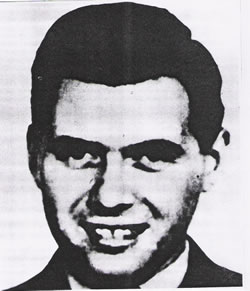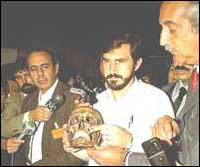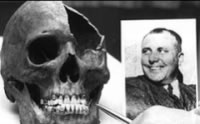By
Xavier Riaud
Everything was said about the end of the life of those two men. Bormann was said to have run away with the Russian march to Germany, and the location of his death remains unknown. He was said to have immigrated to South America, etc. Mengele was said to have reached South America and to have been constantly hunted down by the agents of the Israeli Mossad. Speculations kept gaining momentum. Here is, in few pages, the true story of these two men after the Second World War.
Dr Josef Mengele (1911-1979)
Josef Mengele was born on March 16, 1911. In Guenzburg, Josef was intelligent, refined and popular.
His parents, Karl and Walburga, sent him studying philosophy in Munich and medicine in Frankfurt. In 1935, he defended his PhD thesis which dealt with the racial differences in the structure of the lower jaw.
In 1937, he joined the Nazi Party and in 1938, the SS. In 1942, he served in the 5th SS Panzer Division “Wiking”. He was wounded on the Russian front and was considered physically unfit for service. Then, he volunteered to go to the Auschwitz extermination camp.
During his 21-month stay at Auschwitz, he got involved in the selections of the convoys to the gas chambers. He summarily shot prisoners with his gun.
He was particularly interested in identical twins and tortured his victims before murdering them for an autopsy. He did the same with Gypsies suffering from Noma. He was responsible for killing around 400 000 people.
Mengele left Auschwitz dressed up as a German Infantry soldier. He was taken as prisoner of war near Munich but was released by the Allies.
In 1948, he decided to leave Germany and to restart his life somewhere else. Argentina was his new destination. His father who produced major farm machinery did not have a subsidiary company there but had numerous contacts. Josef widened them.
Mengele flew for Argentina but regularly changed of location fearing to be captured.
In 1958, he divorced his wife, Irene and three years later, he married Martha Mengele, the widow of his brother. She then went to Argentina with her son. During 35 years, despite being seriously hunted down and having different identities, he lived as a good-father.
Dr Pierre-François Puech told me that once, the Mossad, the Israeli Institute for Intelligence and Special Operations, had suspected a man to be the Nazi doctor and for that reason, that man was under close surveillance. Mengele was known to have a diastema (a space) between his upper incisors. The pictures did not show any particular space between his teeth. The SS criminal was somewhere else.
He also lived in Paraguay and in Brazil until his death in 1979. On February 7th that year, he decided to go swimming. He had a heart attack while swimming in the ocean and drowned precipitously. He was brought back to the surface. The Angel of Death was dead.
The police hunting Nazis found a grave bearing the name « Wolfgang Gerhard » in Embu. The body was exhumed and bones were found in 1985. The anthropologist Clyde C. Snow arrived in Sao Paulo as well as the German expert Richard Helmer that summer. The bones were fractured by those who exhumed the remains of the body. Despite this incident, the team was able to work on the fragments. The remains were those of a right-handed Caucasian aged between 60 and 70. There were no dental x-rays and even though Mengele’s fillings were written down in his file, no particular feature was brought to light. Snow and Helmer decided to use the technique of superposing the face on the skull via video. 30 comparison dots were made on the skull and the same was done on Mengele’s picture. They compared the two with the video. If all the dots lined up, then the identification was undeniable. After the recording, the images were superposed and the specialists drew the conclusion that the exhumed skull was the Nazi’s.
Later on, dental x-rays of the SS doctor were found and compared to the teeth of the skull and they undoubtedly attested that it really was Mengele’s.
His family confirmed that the remains were his. And yet, doubts remained until 1992 when a DNA test was carried out on the bones and the SS’s son. The report concluded: “the remains are Josef Mengele’s”.
Dr Josef Mengele, “the Angel of Death”
The diastema between the upper incisors is clearly noticeable.

Wolfgang Gerhard’s skull

Martin Bormann (1900-1945)
Martin Bormann was born in 1900. He was sentenced for complicity to murder in 1924. A year later he joined the NSDAP in Thuringia. In 1933, he became a Reich leader (Reichsleiter) of the NSDAP. From 1933 to 1941, he was the personal secretary of Rudolf Hess. After the flight of Hess to Britain, Bormann became Head of the Party Chancellery (Parteikanzlei) and soon started to be essential to Hitler’s political motivations. He became his personal counselor, and his right-hand man. Everything was checked by him. He was a key figure. He intrigued and absolutely controlled everything only revealing truths serving his own interests.
He was tried at Nuremberg and sentenced to death in absentia.
Bormann was one of the last who left the Führer’s shelter. He left shortly after midnight on May 2. In his pocket, he was carrying Hitler’s last will and testament that he wished he could bring to the German Admiral Karl Dönitz to legitimate his appointment as the new “President of Germany”. Ludwig Stumpfegger, one of Hitler’s doctors, and Hitler Youth leader Artur Axmann were part of his group. Once arrived at the Friedrichstrasse station, they hid themselves to get rid of their distinctions except Bormann who kept his black leather jacket. At the Lerther station, the group parted in two. Bormann and Stumpfegger walked eatswards, on the Invalidenstrasse, towards Stettiner station. Axmann decided to go alone in the opposite direction of his two companions. When he encountered a Red Army patrol, Axmann doubled back to join the group going eastwards. He quickly caught up the two men. On the other side of the Lerther station, next to a railway bridge, he found them dead, lying on their backs with no visible injury marks.
For years, Axmann had been the only witness of the death of his two partners. This had never been considered as real facts. Therefore, Bormann was tried and sentenced to death in absentia during the Nuremberg trial. This gave rise to an important controversy. Bormann was not dead but actually living in South America.
In 1972, Reidar Sognnaes decided to draw up a descriptive list resuming important details concerning Bormann’s dental care. Thanks to American war records, Sognnaes had already received a copy of the US intelligence report of the interrogation of Hitler’s dentist dating back to November-December 1945. Indeed, Blaschke had not only been Hitler’s dentist but also that of other high figures of the Nazi Party. This SS practitioner was questioned on Bormann’s teething of which he gave a full description. Out of his textual data, Sognnaes drew a graph from a report that on December 7, 1972, he personally handed over to the editorial office of the American Dental Association Newspaper. The article was only published in February 1973.
On December 7, 1972, construction workers dug a hole for a water pipe next to the Lerther station and found two bodies, a big and small one. There was a very close coincidence with the presumed location of the death of the two men. An ante-mortem data research was launched.
After the examination, Fritz Echtmann, Blaschke’s prosthetist recognized a three-part dental bridge that he had made for Bormann in 1942. Meanwhile, Stumpfegger’s dental care list was found. All the annotations match Bormann’s teething. All the details written by several dentists many years before his death proved his identity. The doctor’s remains were given back to his family and were buried. And yet, no records seem to exist concerning Bormann. However, there was little doubt on the identity of the smallest body with respect to Blaschke’s and Echtmann’s descriptions. But they were never considered as legal proof. The Stern of December 21, 1972 published the report of the examination of the two bodies as well as some pictures.
When he read the publication, Sognnaes who lived in Los Angeles, was really surprised. He went to Germany from August to September 1973. After investigating many survivors, he was authorized to examine the skull which was sealed up at the Federal court of Munich. He took pictures, x-rays and prints of Bormann’s upper and lower sections of the jaw. Upon his return to the US, he made a cast. He noticed that the three-part dental bridge showed some small incisions which perfectly matched with those made on the lower front teeth. The comparison between the post-mortem elements and those given by Blaschke allowed him to draw the conclusion that the skull was really that of the Nazi.
The most obvious details were written in the Journal of the California Dental Association of 1974. What are they?
The lower right molar was missing. It was replaced by a gold dental bridge spreading from the right lateral incisor to the left central incisor. Porcelain facets were moulded. Blaschke described this making which was recognized by Echtmann, its maker.
The third right lower molar half came through and was decayed. A dental cement bandage had been placed on it during one of Bormann’s last consultations in 1945. The dental pulp was exposed. The dentist had started a root canal treatment of it. The disinfectant placed under the cement strongly smelt. Sognnaes smelt it 28 years after and recognized its features.
The first lower right molar was missing. A gold bridge replaced it from the second premolar to the second molar. Blaschke once again described this making. After the publication of Sognnaes’s article, Bormann’s death on May 2, 1945 in Berlin made little doubt.
On April 4, 1973, the Frankfurt prosecutors officially acknowledged Bormann’s death on the basis of Sognnaes’s work. A DNA analysis was however carried out in 1999 which only confirmed the conclusions drawn in 1973.
A very last observation was made between the teeth of the two skulls. Glass bits were found on them. Therefore, it was almost indisputable that the two men had not been shot in the back as it was thought for a long time, but rather that they had decided to commit suicide by crunching a cyanide capsule.

Martin Bormann’s skull
|